The Costumes in Ryan Murphy's 'Hollywood' Are a Love Letter to 'The Golden Age of Tinseltown'
Designers Lou Eyrich and Sarah Evelyn dressed big-screen ingenues, played by Samara Weaving and Laura Harrier, in mostly vintage.
Warning: Spoilers for 'Hollywood' (and history) below.
Ryan Murphy has described "Hollywood," his latest offering for Netflix, as a "love letter to the Golden Age of Tinseltown." But the 10-episode series is more of tribute to the progressive, inclusive and pioneering film industry that could have, should have been (and is finally happening now, bolstered, in part, by the prolific creator's many projects).
Set in a post-World War II Los Angeles, the alternative history of "Hollywood" asks: What if a woman called the shots at a major motion picture studio? What if she gave the green-light for a trailblazing movie directed by a biracial man of Filipino heritage (played by Murphy regular Darren Criss), written by a Black gay screenwriter (Tony winner Jeremy Pope) and starring a WOC ingenue (Laura Harrier) — and not the blonde daughter of the studio boss? Also, what if real-life heartthrob Rock Hudson (Jake Picking) didn't have to stay closeted for his entire career? And what if Chinese-American actor Anna May Wong (Michelle Krusiec) hadn't been cast in "Dragon Lady" stereotypes for most of her career?
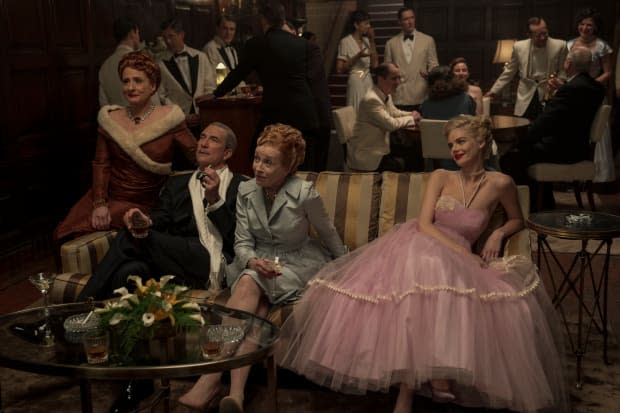
Murphy's starry-eyed vision offers a revisionist narrative of the American entertainment industry. But the show's expansive range of costumes — by Lou Eyrich (his longtime designer) and Sarah Evelyn — remain period-authentic, all the way down to the fabrics, trims and belt buckles (painstakingly sourced by costumer Kit 'Pistol' Scarbo).
"From the beginning, Ryan really emphasized that he loves the costume designers of that period: Adrian, Orry-Kelly, Edith Head, of course, and Walter Plunkett," says Eyrich, over the phone from Los Angeles. She and Evelyn dove into research of big-screen idols from the '40s and collaborated closely with a very "hands-on" Murphy.
Related Articles:
Gwyneth Paltrow Gardens in a Caroline Herrera Gown in 'The Politician'
'The Assassination of Gianni Versace: American Crime Story' Features Authentic Vintage Versace
How the 'Feud: Bette and Joan' Costume Designer Revisits Old Hollywood Glamour (and Drama) Through Wardrobe
Eyrich, who's won five Emmys (so far) for her work on various Murphy projects, established and co-designed the premiere, and consulted on the remainder of the season. Evelyn, who last summer dressed Idris Elba in a motorcycle-riding supersuit in "Fast & Furious Presents: Hobbs & Shaw," took charge of the costumes in the other nine episodes.
"We leaned into the very Hollywood-ness of it all: 'Casablanca,' 'Woman of the Year,' 'Double Indemnity,'" explains Evelyn, also over the phone from L.A. "We really started looking at all the classic movies and kept watching, watching and watching — all the way through to the very obscure B-level movies."
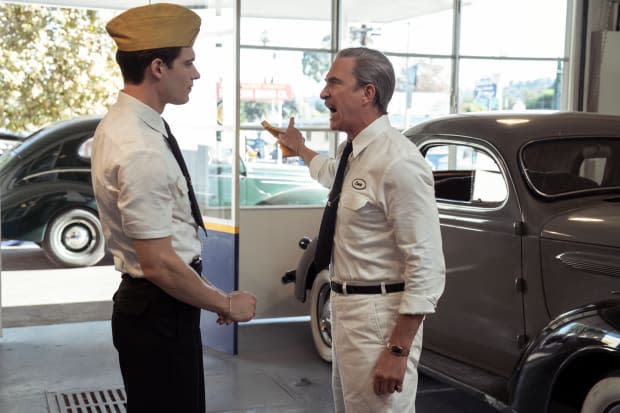
The action kicks off at the phallically-named Golden Tip, a full-service — wink, wink — station run by the very smooth Ernie (Dylan McDermott, above). The industrious business owner, clad in "a crisp, clean uniform" of all-white, oversees his staff of exceptionally handsome Silver Screen climbers, including war vet-turned-fledgling actor Jack (David Corenswet, "The Politician") and scribe Archie (Pope). Considering their pristine uniforms, the guys aren't spending much time repairing grimy cars, ya know?
"Ryan liked the idea of the pump jockeys with the black pants and Ernie in the white, so [it's clear] he's the leader," says Eyrich. She and Evelyn searched for weeks before landing on the period-accurate material they used to custom-build the high-waisted, flat-front trousers — especially since they needed to accommodate 21st century-trained physiques. "I mean those guys aren't too hard to fit clothing on, but we did work hard on the fit," Evelyn notes.
While Ernie wore the authoritative driving cap, his staffers stayed uniform in khaki flight-style toppers. "Ryan liked the envelope hat because it made the boys look younger. Ernie would wear the 8-point to stand out," explains Eyrich. For his off-hours, Ernie's dapper driving jackets and natty three-piece tailored suits were inspired by debonair Fred Astaire and Cary Grant, especially in their own real-life, late-'40s street-style looks.
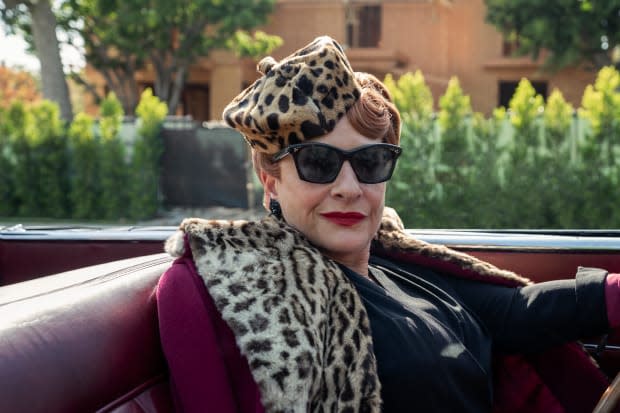
Former silent-film actor and trophy wife-turned-studio head Avis (played by Broadway luminary — and noted anti-texting-during-a-performance proponent — Patti LuPone) is, understandably, regular client at The Golden Tip. She makes her grand debut pulling into the station stunting in a leopard-print, fur-collar jacket with matching pill-box hat (above).
"Barbara Stanwyck and Joan Crawford were inspirations, for sure. And Patti Lupone can pull off costumes," says Evelyn, who custom-designed all of Avis's jewel-studded and fur-lined power suits and sensational wrap-front, puff-sleeve dresses. "There was definitely a very 'Avis' look."
For the full effect, Evelyn also custom-built '40s-style foundation garments to create the authentic "V-line" — strong shoulders culminating in a cinched, "sharp waistline," explains Eyrich. They're not the most comfortable to wear, but LuPone fully committed: "She's a Broadway girl. She knows how to play it," she laughs.
Less restricting, but just as glam? Avis's fur- and feather-trimmed at-home silk dressing gowns, which are also bespoke — with the exception of a vintage-inspired Boudoir by D'Lish robe, modified by Evelyn with extra, very Avis flourishes.
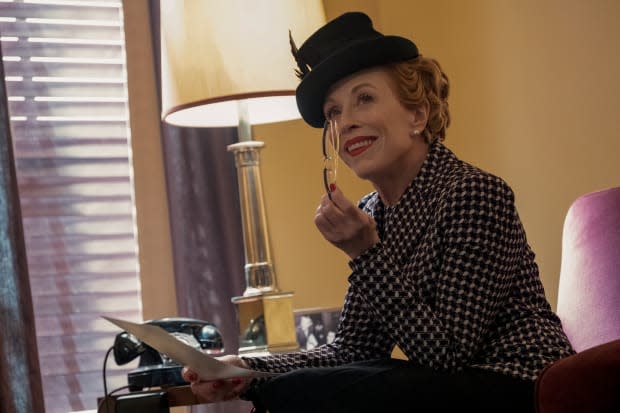
For studio exec and ally Ellen Kincaid (played by Holland Taylor, who shockingly hasn't been in a Ryan Murphy joint yet), inspiration originated closer to home.
"Holland has very clear memories of her own mom [painter Virginia Taylor], in the 1940s, who was gorgeous and really well-dressed," says Evelyn, who also incorporated menswear influences from trouser icons Marlene Dietrich and Norma Shearer.
Mostly custom-designed, Ellen's impossibly chic three-piece pantsuits and jaunty prints balance a "'40s panache inside of this very classy restraint," Evelyn adds. Eyrich also credits in-house tailor Joanne Mills for "perfecting" a custom silhouette to flawlessly adapt the era's power-shouldered volume for the petite Taylor.
As for the newbie class, Avis's spoiled daughter Claire (Samara Weaving, "Ready or Not") boasts screen presence in her genes — and she dresses the part.
"Claire was very much the siren: tight skirts and really defined waists," says Evelyn. The influence of classic bombshells — Marilyn Monroe, Veronica Lake, Ava Gardner and Lana Turner — are evident in her silky blouses, body-hugging silhouettes, luxurious fur wraps slung over her padded shoulders and sky-high, peep-toe platform sling-backs.
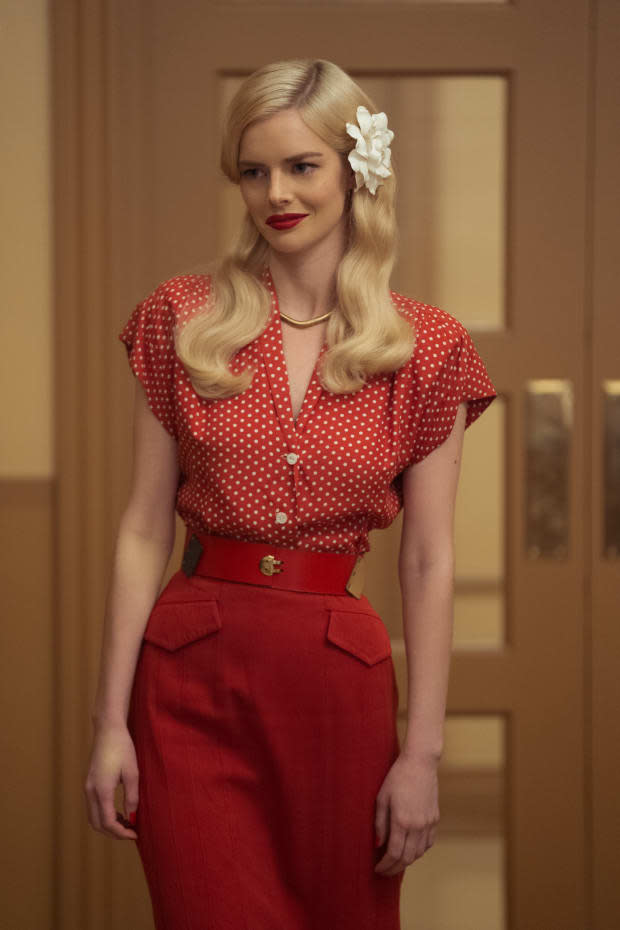
As Claire connects with her mother and becomes a supporting — and supportive — cast member in Raymond (Criss)'s game-changing movie, her costumes evolve, as well. "She really became softer and found her soul," says Evelyn, pointing to the floaty pink tulle gown that Claire wears to the Oscars (second from top). "We got to see her vulnerability, and, if anything, we incorporated that into the silhouettes with a little bit of color."
Fellow contract-player Camille (Harrier) first refers to Claire as her "competition," and their differing perspectives and experiences are illustrated by her color palette of "warm butterscotches and cinnamons" and her repetition of key pieces, versus Claire's red hues and never-ending wardrobe.
"It was about a more 'effortless It Girl' against Claire's more on-the-nose bombshell," explains Evelyn. "Camille was a bit more textured, a bit more pattern-on-pattern." She and Eyrich looked to Katharine Hepburn and Lauren Bacall for reference. Early ready-to-wear and separates pioneering designer Claire McCardell also served as an inspiration for that cool, relaxed All-American aesthetic. Evelyn estimates that Harrier and Weaving wore 75% to 80% vintage pieces.
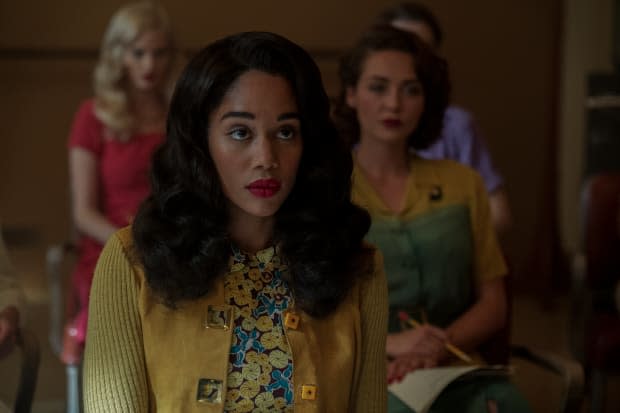
Initially relegated to stereotyped maid roles, Camille lands her big break starring in Raymond's movie in what would have been a groundbreaking move in the late '40s. Leading up to the finale, Camille finds a mentor in Hattie McDaniel (Queen Latifah), who won the Best Supporting Actress Oscar in 1940 for her role as a slave in "Gone With the Wind." (McDaniel made history as the first African-American to be nominated for and to win an Academy Award, but, because of segregation, sat separately from the rest of her cast during the ceremony.)
When Camille enters the show's fictionalized version of the 1949 Oscars, she claims her place in the theater with her cast mates and director-partner Raymond. Her custom-designed, strapless pink ball-gown, with a floral garland adorning the waist (below), immediately brings McDaniel's real-life turquoise, gardenia-accented Oscars look to mind. But Evelyn thanks the "costume gods" for the art-imitates-life kismet moment that felt like an homage to the earlier milestone. "It was for sure a costuming happy accident," she says.
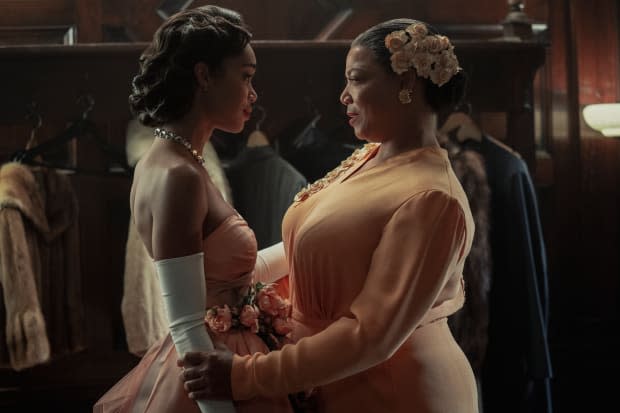
While Evelyn and Eyrich replicated McDaniel's historically-documented ensemble for a flashback, the duo and their team also enjoyed the freedom to design costumes for depictions of real-life luminaries living out their imagined alt-histories. "Sometimes it's about finding the essence of the actor, instead of exactly recreating something," says Evelyn, before adding: "Those characters had so much depth you could read about and these reservoirs of pain that were interesting."
Los Angeles-born Wong is considered to be the first Chinese-American film star — but one confined to racist and xenophobic rules and societal perceptions, especially of that time.
She found silent film fame in the '20s, but then decamped to Europe for more opportunity due to miscegenation laws that prevented interracial couples on-screen (and off) in the U.S. After she returned to the States in 1935, she was notoriously passed over — early in a history of Hollywood whitewashing — for the role of O. Lan, a Chinese character in the film adaptation of Pearl S. Buck's "The Good Earth." German-American actress Luise Rainer not only won the role, but also an Oscar for her performance.
"Ryan definitely had a vision for Anna May Wong, and it was really 'faded glamour.' What would someone who was glamorous and talented and who would have made it, but for Hollywood's own shortcomings? What would she be wearing?" explains Evelyn of her thought process. "From there, then it just got really fun, because you're like, 'Oh, it must be this gold-satin-dressing-gown situation.'"
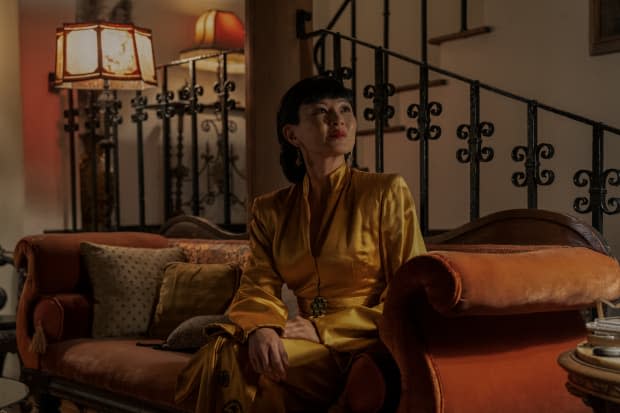
Wong's high-neck and peplum-ed silhouettes skewed more late-'30s and early-'40s, to hint at the financial impact of her career barriers while still maintaining her starlet bonafides. "She wore mostly vintage pieces and then we'd modify a little bit to add some fur or something like that," Evelyn adds.
As part of this love-letter care package to Hollywood, Eyrich and Evelyn also found themselves dressing the Golden Age versions of their would-be colleagues, especially in a spirited pre-screen test montage in which Jack and Rock endure the same amount of glam-session primping and appearance-assessing as their female counterparts.
"We would design for costumers and a costume designer in our background cast and those were some of the most fun days," says Evelyn. "Again, Lou's done this before, but I was a totally geeked out about it."
All episodes of 'Hollywood' stream on Netflix on Friday, May 1.
Never miss the latest fashion industry news. Sign up for the Fashionista daily newsletter.